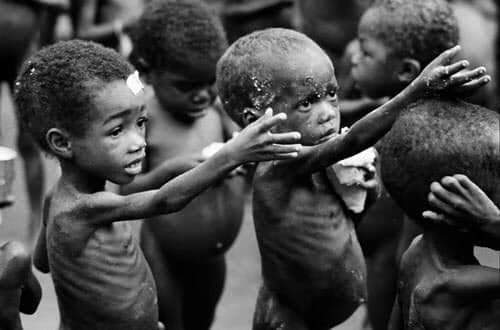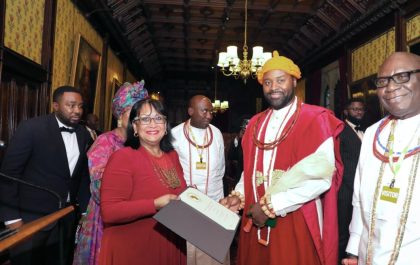-COMPASSION INTERNATIONAL
Poverty is a complex problem. The most widely held definition of poverty measures poverty in economic terms.
The World Bank defines extreme poverty as living on less than $2.15 a day, or about $700 per year, which puts 10 percent of the world’s population below the global poverty line. But global poverty has ensnared billions more than this 10 percent. Half of the world’s population live on less than $2.50 a day, another widely accepted poverty line, albeit on considerably different than in the United States.
The poverty threshold for a family of four in the United States is just over $26,000 a year. That is more than 36 times what a family of four living in absolute poverty in a low-income country survives on. But poverty is much more than a lack of money. Poverty is not strictly about measuring household income, income inequality, or the need for economic growth. Poverty changes everything about a person’s life experience. It impacts all of a person’s basic needs and touches every aspect of his or her existence.
Poverty is daily hunger, child malnutrition, a lack of access to clean water, shelter, and health care, little or no opportunity to go to school or learn a trade, constant fear for the future and increased risk of exploitation and abuse.
Poor people often lack hope for the future because they live in a lie. The lie of poverty, that is reinforced day-in and day-out is, “You don’t matter. You’re worthless.” Whether in South Sudan, Ethiopia, Uganda or Zambia, the poor in the world’s poorest countries live in hopelessness…every day, in multiple ways.
Imagine not being able to provide enough food for your children or pay for a hospital visit when a child is sick or injured. Imagine the guilt, grief, and despair. The poor are helpless in the face of war and natural disasters. When natural disasters and conflict occur, the poor suffer the most. They are unprotected, uncared for, and unnoticed.
Overcrowded urban areas where millions of the poor live in slum conditions increase the risk of disease and increase the death toll when conflict and war erupt or an environmental disaster hits.
Poverty often causes the poor to put pressure on their environment, and in turn the environment contributes to the suffering the poor endure. Damage to the natural environment in which the poor live increases the impact floods and other natural disasters have. But “natural disasters” are as much a result of poor government, bad infrastructure, population density, rampant population growth and unequal living conditions as anything else. Extreme poverty helps create the disaster.
Limited access to sanitation and clean water lead to poor hygiene practices and more disease, which hinder the ability of the poor to work or attend school. And when someone more powerful takes advantage of them, from withholding wages or payments to trafficking a child, the poor are unable to pursue justice, for they lack the money and connections to do so.
Although girls are more likely to be victims of sexual abuse and sex trafficking, exploitation does not discriminate based on gender. All of the world’s poor are targets. Despite this harsh reality, it’s the feeling that you don’t matter, like your life will never get better, that is the most crushing and demoralizing aspect of poverty. It’s also why poverty reduction efforts and programs to lower the poverty rate must be holistic, reaching into every aspect of the human experience.
According to the World Data Lab, 42 African countries are in poverty, and in 16 of those countries, the poverty rate is rising. Twenty-seven of the world’s 28 poorest countries are in Sub-saharan Africa. Each of these countries has a poverty rate of over 30 percent.
While the absolute number of people living in global poverty has decreased over the last several decades, in Sub-saharan Africa, the number has increased, and substantially so. In 1990, 278 million people in Sub-saharan Africa lived in poverty. By 2015, that number had grown to 413 million, and it’s now approaching 440 million. Hunger in Africa is also on the rise. Two hundred fifty-six million Africans are hungry, an increase of 44 million since 2014.
How is Poverty Measured in Africa?
Poverty in Africa, like elsewhere, is typically measured in economic terms. The standard measure is the World Bank’s definition of living on less than $2.15 per day. But as we’ve mentioned, economics cannot be the sole measure and determinant of poverty.
The World Bank recognizes that poverty is hunger, lack of shelter, being sick and not being able to see a doctor, not having access to school, not knowing how to read, not having a job, fearing for the future, losing a child to a curable illness, and living one day at a time. It also understands that poverty is powerlessness and lack of representation and freedom. Because this broader measure of poverty expands upon the economic definition of poverty, the World Bank developed indicators to assess the non-income dimensions of poverty. The indicators include education, health, access to social services, vulnerability, social exclusion, and access to social capital.
What are the Causes of Poverty in Africa?
One in three Africans live below the global poverty line. They make up 70 percent of the global poor, and their numbers are rising. Despite the overwhelming number of extremely poor people in Africa, the causes of poverty on the continent are no different than the causes of poverty around the world. They can be grouped into two primary categories external or cultural factors and internal elements.
When you’ve never seen someone escape a life of poverty, you have no reason to believe that escape is possible. Poverty becomes your lot in life and part of your identity. You can’t imagine a better future because you’ve never seen one, or if you have, it’s a future for other people, not a future for someone like you. This lack of hope keeps people in poverty even when an opportunity that could change their lives presents itself.
Ways to Reduce Poverty in Africa?
Breaking the cycle of poverty involves a holistic approach to development. It involves providing food and access to clean water, health care and education. It also involves creating healthy environments where children can grow and learn in safety, places where they know they are being cared for and protected. This protection is especially critical in areas where children are so often taken advantage of.
Financial assistance is part of the solution, but money alone will not solve the problem. Since poverty affects every aspect of a person’s existence, ending poverty requires addressing all the different ways that poverty has told its victims, “You are helpless, and you don’t matter.”
Reducing poverty in Africa requires holistic support addressing everything from social development and physical health, to education and vocational training, protection and justice for victims of abuse, and economic and agricultural productivity.
Related posts
Global | Didi Angaye Earns A Distinction Award, Another Feather To The Cap
On a bright sunny day, in the month of July, 2024, the prestigious Staffordshire University located in the West Midlands of England organised its Award giving and Graduation ceremony to honour graduates of various educational programmes and courses which it offers. Didi Timipah Angaye,…
Olu Of Warri Bags Award In UK, Wife Advocates Return To Cultural Values
The Olu of Warri, Ogiame Atuwatse III, has received the Leadership and Community Development award at the 14th African Achievers Awards (AAA), which took place at the Parliament House, United Kingdom. The award was presented by a member of the House of Lords, London, Rt…
Brit Awards | Asake, Burna Boy And Other ‘New Cats’ Get Nominations
Nigerian singers Burna Boy, Asake, and Rema have been nominated for the 2024 Brit Awards. The nomination list for the annual music awards show was released on Wednesday 25, January 2024. Burna Boy and Asake made the ‘Best International Artiste’ category, while ‘Calm…
Brit Awards 2024 | The Full List Of Artist(e)s
This year’s Brits nominees have been revealed ahead of the ceremony in London in March. Dua Lipa is the first star confirmed to perform at the event – but how many awards is she up for? Musicians including Raye, Central Cee, J Hus and Blur are also…
Despite Increased Transfer Volume And Institutional Adoption, Bitcoin Stays Below $60K
Bitcoin’s price hovers around $59K as increased transfer volume indicates a stable demand among investors. CryptoQuant data indicates buyers are absorbing the panic selling pressure around the $57K price level. Bitwise’s latest report suggests that institutional investors are still buying Bitcoin despite the recent price…
Traders Focus On Meme Coins As Bitcoin, Ethereum And XRP Erase Recent Gains
Bitcoin, Ethereum and XRP dip under key support levels at $60,000, $2,600 and $0.60 respectively. Tron ecosystem’s meme launchpad SunPump generates over $1.1 million in revenue within twelve days of its launch. Tron network daily revenue reached a record high of $26.83 million on Tuesday,…
Top 10 Cryptocurrencies To Invest in January 2024
-Michael Adams From Bitcoin and Ethereum to Dogecoin and Tether, there are thousands of different cryptocurrencies, making it overwhelming when you’re first getting started in the world of crypto. To help you get your bearings, these are the top 10 cryptocurrencies based on their market…
The Risk And Reward Of ChatGPT In Cybersecurity
Juan is an experienced CTO with a demonstrated history of working in the computer and network security industry. He is an information technology professional skilled in SAP and Oracle applications, computer forensics, vulnerabilities research, IPS/IDS and information security. Unless you’ve been on a retreat in…











